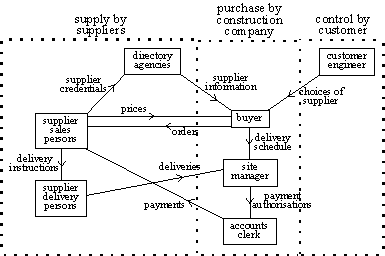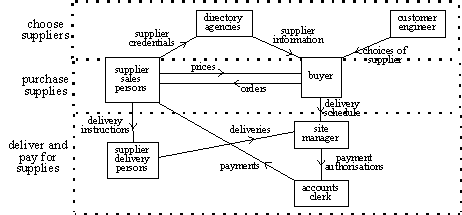
| click here for POSD home page |
Click on first view, second view, and third view to see just three structural views derived from the composition structure. Of course there may be many other structural views as well as the three shown. Each view results from a different understanding of what is important and what unimportant about the system.

The above diagram gives a first way of structuring the example system -
the construction supply process. It shows (with dotted lines) how the process
could be structured into three large components to represent the roles of the
three companies participating in the process. Note that some of the lines
(representing flows of information or artifacts in the initial diagram) are here
shown crossing the dotted lines (representing the boundaries between the
companies). This indicates that these lines represent flows of information or
artifacts between the companies.

The above diagram gives a second way of structuring the example system
- the construction supply process. It shows (with dotted lines) how the process
could be structured into three large components to represent the three stages in
the supply process - choose suppliers, purchase supplies, and deliver (and pay
for) supplies. Note that the boundaries between the large components cut
through the rectangles representing the roles "supplier sales persons"
and "buyer", thus indicating that these roles participate in more than
one stage of the supply process. Note also that there is a time element to this
structure, a particular supply is purchased after the supplier has been chosen
but before the supply is delivered.

The above diagram gives a third way of structuring the example system -
the construction supply process. It shows (with dotted lines) how the process
could be structured into two large components. One of the components contains
the parts of the system concerned with registering suppliers, the other the
parts concerned with using suppliers. This diagram would be useful to those
primarily interested in how suppliers were registered. In fact, this way of
structuring the process looks rather boring as it shows only one mechanism for
registration, but it would be less boring if the process had many such
mechanisms (and there are such processes).
last revision: 21st June 1997